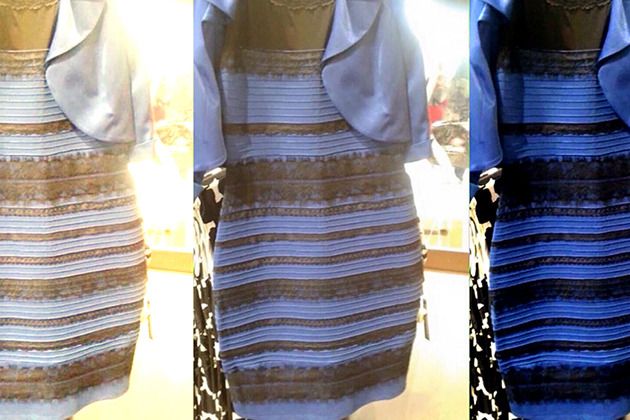#TheDress became a viral sensation at the end of February, triggering heated arguments: Is the dress blue and black, or white and gold? Though the trivial debate was blown tiresomely out of proportion, the disagreements have revealed amazing differences in how our eyes and brains have developed to perceive colour.
To see colours and composite images, wavelengths of light hit the retina in the back of the eye. In the retina, light is sorted by cone cells sensitive to red, blue, or green wavelengths. From there, activated cone cells send action potentials along the optic nerve to the visual processing cortex of the brain. The combination of signals allows our brain to make near-instantaneous judgments on the colours around us.
“Ninety-nine per cent of the time we’ll see the same colours,” Dr. Julia Haller, the ophthalmologist-in-chief at Wills Eye Hospital in Philadelphia explained to CNN. “But the picture of this dress seems to have tints that hit the sweet spot that’s confusing to a lot of people.”
The light from the object that enters our eyes is dependent not only on the object’s intrinsic properties but also on the object’s surrounding illumination. The ability to assign fixed colours amidst changing ambient lighting is called colour constancy. Colour constancy allows us to manage these ambient differences, like sunlight at noon versus at sunset.
“Our visual system is supposed to throw away information about the illuminant and extract information about the actual reflectance,” explained neuroscientist Jay Neitz from the University of Washington. “I’ve studied individual differences in colour vision for 30 years, and this is one of the biggest individual differences I’ve ever seen.”
The discrepancy for this particular image lies in the lack of information about the dress’s surroundings. Though the background appears light in color, the source of illumination is not clear. If the dress appears washed out in bright light, then often the dress is seen to be blue and black. But if the dress is perceived under a dark shadow, it is more likely that the dress is seen as white and gold. When the context of illumination varies, so will visual perception.
What do these differences mean? Why do some view the dress in a shadow while others perceive an overexposed room?
“Why do some people love cilantro and others say it tastes like soap?” Haller responded. “Why do some people have perfect pitch and others are tone deaf? It’s the same with vision—our sensory apparatus is fine tuned.”
Our highly developed sense of colour likely stems from a biological evolutionary advantage. As trichromats—those who have red, green, and blue sensitive cone cells—human ancestors were more likely to perceive a difference in colour between a ripe fruit and its surrounding foliage compared to dichromats—almost all non-primate mammals. Heightened sensitivity to colour differences thus conferred a greater chance of survival to fellow trichromats. Our ability to sense a wide array of color likely means there are slight variations in our visual information filtering. The differences of perceived dress colour is therefore likely the product of evolutionary variability.








